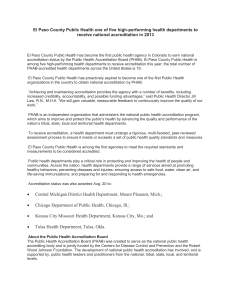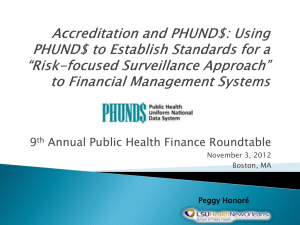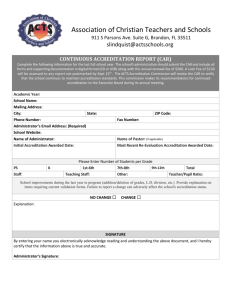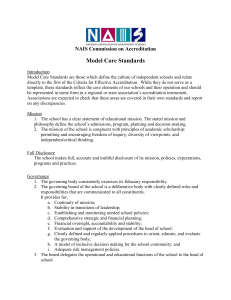Exploring Tribal Public Health Accreditation_DRAFT
advertisement
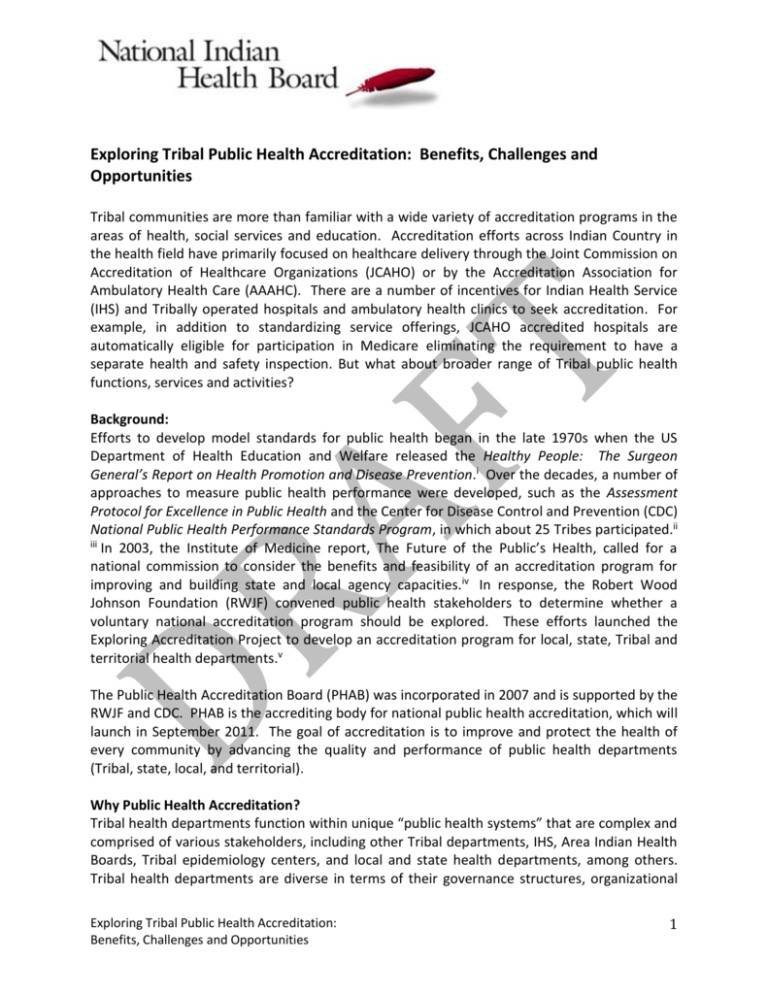
Exploring Tribal Public Health Accreditation: Benefits, Challenges and Opportunities Tribal communities are more than familiar with a wide variety of accreditation programs in the areas of health, social services and education. Accreditation efforts across Indian Country in the health field have primarily focused on healthcare delivery through the Joint Commission on Accreditation of Healthcare Organizations (JCAHO) or by the Accreditation Association for Ambulatory Health Care (AAAHC). There are a number of incentives for Indian Health Service (IHS) and Tribally operated hospitals and ambulatory health clinics to seek accreditation. For example, in addition to standardizing service offerings, JCAHO accredited hospitals are automatically eligible for participation in Medicare eliminating the requirement to have a separate health and safety inspection. But what about broader range of Tribal public health functions, services and activities? Background: Efforts to develop model standards for public health began in the late 1970s when the US Department of Health Education and Welfare released the Healthy People: The Surgeon General’s Report on Health Promotion and Disease Prevention.i Over the decades, a number of approaches to measure public health performance were developed, such as the Assessment Protocol for Excellence in Public Health and the Center for Disease Control and Prevention (CDC) National Public Health Performance Standards Program, in which about 25 Tribes participated.ii iii In 2003, the Institute of Medicine report, The Future of the Public’s Health, called for a national commission to consider the benefits and feasibility of an accreditation program for improving and building state and local agency capacities.iv In response, the Robert Wood Johnson Foundation (RWJF) convened public health stakeholders to determine whether a voluntary national accreditation program should be explored. These efforts launched the Exploring Accreditation Project to develop an accreditation program for local, state, Tribal and territorial health departments.v The Public Health Accreditation Board (PHAB) was incorporated in 2007 and is supported by the RWJF and CDC. PHAB is the accrediting body for national public health accreditation, which will launch in September 2011. The goal of accreditation is to improve and protect the health of every community by advancing the quality and performance of public health departments (Tribal, state, local, and territorial). Why Public Health Accreditation? Tribal health departments function within unique “public health systems” that are complex and comprised of various stakeholders, including other Tribal departments, IHS, Area Indian Health Boards, Tribal epidemiology centers, and local and state health departments, among others. Tribal health departments are diverse in terms of their governance structures, organizational Exploring Tribal Public Health Accreditation: Benefits, Challenges and Opportunities 1 infrastructure, and whether they contract or compact IHS, or other federal agency, services. Public health accreditation was developed on the premise that, regardless of how a Tribal health department is structured or governed, everyone, regardless of where they live, should reasonably expect the local health department to meet certain standards. For purposes of accreditation, a Tribal health department is defined as: A federally recognized Tribal government1, Tribal organization or inter-Tribal consortium, as defined in the Indian Self-Determination and Education Assistance Act, as amended. Such departments have jurisdictional authority to provide public health services, as evidenced by constitution, resolution, ordinance, executive order or other legal means, intended to promote and protect the Tribeʼs overall health, wellness and safety; prevent disease; and respond to issues and events. Federally recognized Tribal governments may carry out the above public health functions in a cooperative manner through formal agreement, formal partnership or formal collaboration. As evidenced by inclusion on the list of recognized Tribes mandated under 25 U.S.C. § 479a-1. Publication of List of Recognized Tribes. 1 National public health department accreditation consists of a set of standards by which to measure performance and recognize those departments that meet the standards. Accreditation provides a means for identifying and prioritizing improvement opportunities, enhance management, and strengthen relationships among Tribal public health system partners. Public health accreditation standards address a range of core public health activities and services, based on the Core Functions of public health and the Essential Public Health Services (http://www.cdc.gov/nphpsp/essentialservices.html). PHAB standards fall within 12 domains as summarized in Table 1. Table 1. Summary of PHAB Domains Conduct and disseminate assessments focused on population health Domain 1: status and public health issues Domain 2: Investigate health problems and environmental public health hazards Domain 3: Inform and education about public health issues and functions Domain 4: Engage the community to identify and address health problems Domain 5: Develop public health policies and plans Domain 6: Enforce public health laws Domain 7: Promote strategies to improve access to health care services Exploring Tribal Public Health Accreditation: Benefits, Challenges and Opportunities 2 Domain 8: Maintain a competent public health workforce Domain 9: Evaluate and continuously improve health department processes, programs and interventions Domain 10: Contribute to and apply the evidence base of public health Domain 11: Maintain administrative and management capacity Domain 12: Maintain capacity to engage the public health governing entity The PHAB standards are grouped into one of the 12 domains and are the required level of achievement that a health department is expected to meet. Each standard has corresponding measures to provide a way of evaluating whether a standard is met. All of the standards are the same for Tribal, state and local health departments. The majority of the measures are the same or similar, with slight differences in wording or guidance specific to the type of health department. Exploring Tribal Public Health Accreditation: The National Indian Health Board is a non-profit organization that represents and advocates on behalf of 565 federally recognized Tribes. Since 1972, NIHB has advised the U.S. Congress, federal agencies (such as Indian Health Service (IHS), the Centers for Disease Control and Prevention (CDC), the Centers for Medicaid and Medicare), private foundations, and other entities on health care issues impacting American Indians and Alaska Natives. NIHB has played a major role in focusing attention on Indian health disparities and the need for increased health care and public health services, resulting in national health care policies that increase access to and utilization of public health services and progress for Tribes. In 2008, NIHB received funding from the Robert Wood Johnson Foundation (RWJF) to assess the feasibility of promoting voluntary public health accreditation and developing public health standards in Indian Country. This assessment was part of a larger national initiative of the Public Health Accreditation Board (PHAB), funded by RWJF and CDC, to implement voluntary public accreditation for state, territorial, tribal and local public health departments. To complete the feasibility study, NIHB successfully established an 18 member advisory board, conducted a National Call for Input on the Standards and Measures, and finalized a Strategic Plan to support tribal participation in voluntary public health accreditation. Overall, the Advisory Board determined that voluntary tribal public health accreditation was feasible and identified a number of potential benefits, challenges and opportunities. Benefits Exploring Tribal Public Health Accreditation: Benefits, Challenges and Opportunities 3 NIHB’s Tribal Public Health Accreditation Advisory Board Members identified potential benefits of accreditation through national and regional Tribal roundtables and stakeholder interviews. The following is a summary of what emerged from Tribal input: Responsibility and visibility. Implementing accreditation standards can support Tribal governments in their efforts to improve their community’s health. Performance feedback and quality improvement. The accreditation assessment process provides valuable, measurable feedback to public health programs on their strengths and areas for improvement. Valuable partnerships. The accreditation process encourages strong, active partnerships between public health practitioners, stakeholders and community members in Indian Country. Reducing health disparities. The accreditation process promotes building and enhancing public health services so that the same level of high quality public health services is available to everyone. Challenges The greatest challenge for Tribal health departments pursuing public health accreditation may very well be dependent upon the complexity of their public health system. Contributors to the complexities may include a lack of uniformity across Tribal health departments, relationships with system stakeholders, public health workforce needs, and public health capacity and infrastructure. Since a number of standards include measures that require documentation of collaboration and coordination of essential public health functions and services, formal partnerships with governmental entities, such as IHS, local and state health departments and others, will be critical to health departments seeking accreditation. Opportunities Despite the potential challenges for Tribal health departments seeking accreditation, the opportunity for Tribes to engage in the accreditation process can highlight strengths and allow Tribal health departments to identify and address areas for quality and performance improvement. Such a process can raise the level and quality of Tribal public health activities, improve decision-making and possibly lead to better health outcomes for future generations. The accreditation process also facilitates a greater understanding of the functions and roles of health department staff and public health systems by promoting greater coordination among Tribal, state and local health departments. Recommendations: Although a great deal of work has been accomplished in preparing for accreditation of Tribal health departments, little is known about Tribal readiness for accreditation. NIHB has held a number of focus groups and roundtables with Tribal health directors and a few significant themes have emerged: Exploring Tribal Public Health Accreditation: Benefits, Challenges and Opportunities 4 Outreach, education and information sharing with Tribal leaders, health directors, Tribal public health system stakeholders and others is greatly needed to raise awareness about public health accreditation Funders and supporters of accreditation need to invest equally in tribal infrastructure development, capacity building and performance improvement as has been invested in local and state health departments. Technical assistance and training that are relevant to Tribal public health systems need to be provided to improve quality improvement efforts and increase readiness for accreditation Tribally specific models, templates, and samples are needed to prepare the three accreditation pre-requisites (community health assessment, community health improvement plan, departmental strategic plan) Tribes need to continue to document and evaluate programs using practice-based evidence to develop promising, best and evidence based practices for tribal public health systems NIHB is grateful for the support it has received from the RWJF and accreditation partner organizations, including the CDC, PHAB, NACCHO, the Association of State and Territorial Health Officials, the Nation Association of Local Boards of Health and Accreditation Coalition member organizations and individuals. For more information, see NIHB Exploring Tribal Public Health Accreditation Strategic Plan at http://nihb.org/docs/11192009/NIHB_TPHA Strategic Plan FINAL 09 06 09.pdf. i US Department of Health Education and Welfare. Healthy People: The Surgeon General’s Report on Health Promotion and Disease Prevention. Washington, DC: US Department of Health Education and Welfare; 1979. USDHEW_PHS Publication No. 79-55071. ii National Association of County and City Health Officials. Assessment Protocol for Action Through Planning and Partnerships. Washington, DC: National Association of County and City Health Officials; 1998. iii National Public Health Performance Standards Program. Centers for Disease Control and Prevention website. http://www.cdc.gov/nphpsp/index.html. Published 2002. Accessed July 27, 2011. iv Institute of Medicine. The Future of the Public’s Health in the 21st Century. Washington, DC: National Academies Press; 2003. v Bender, K, Benjamin, G., et al. Final Recommendations For A Voluntary National Accreditation Program For State And Local Health Departments: Steering Committee Report. J Public Health Management Practice, 2007, 13(4), 342–348 Exploring Tribal Public Health Accreditation: Benefits, Challenges and Opportunities 5


